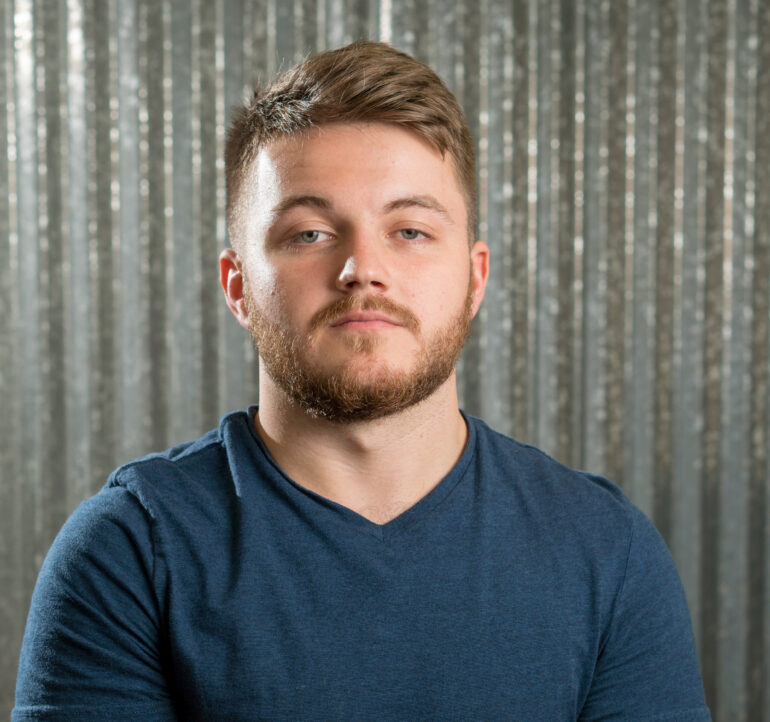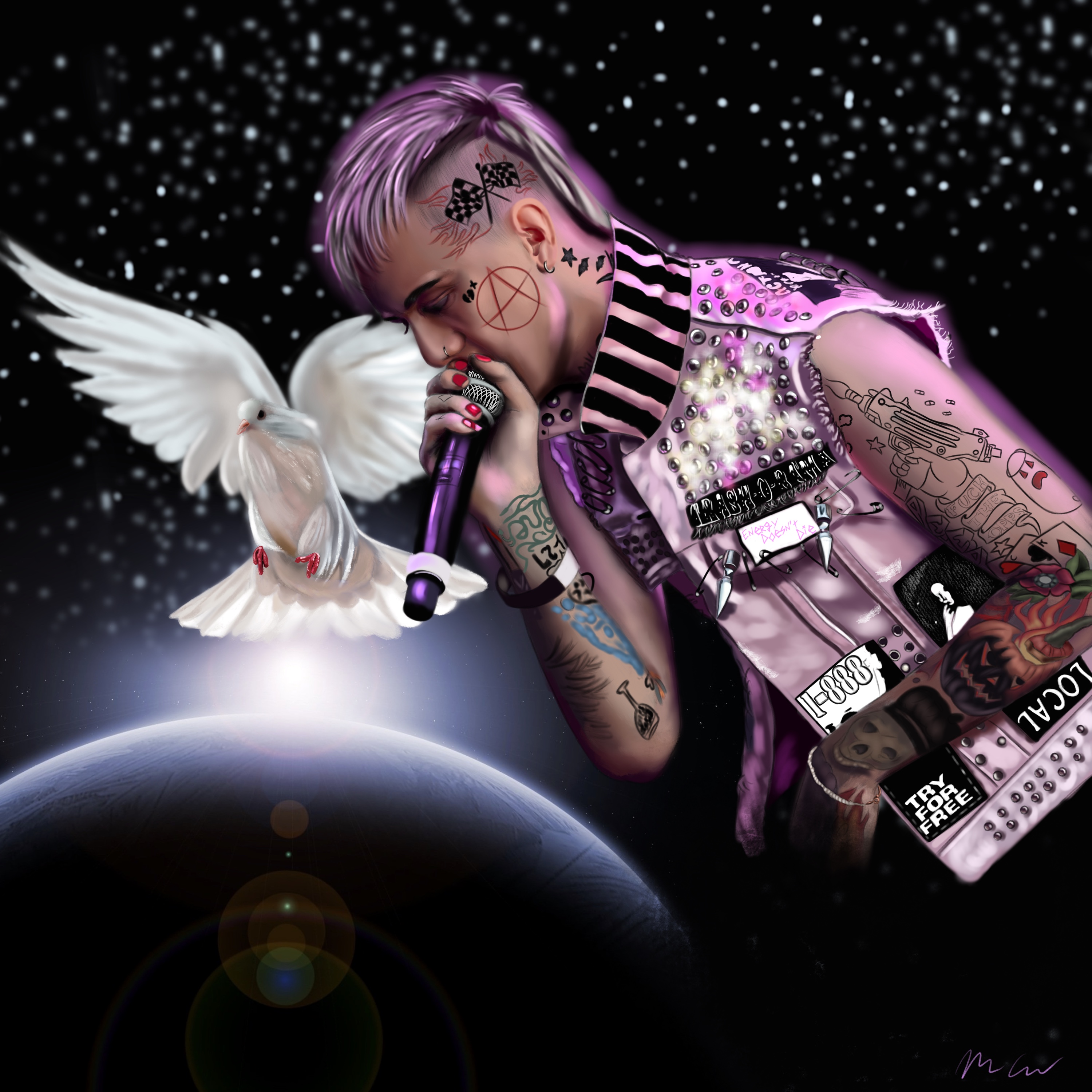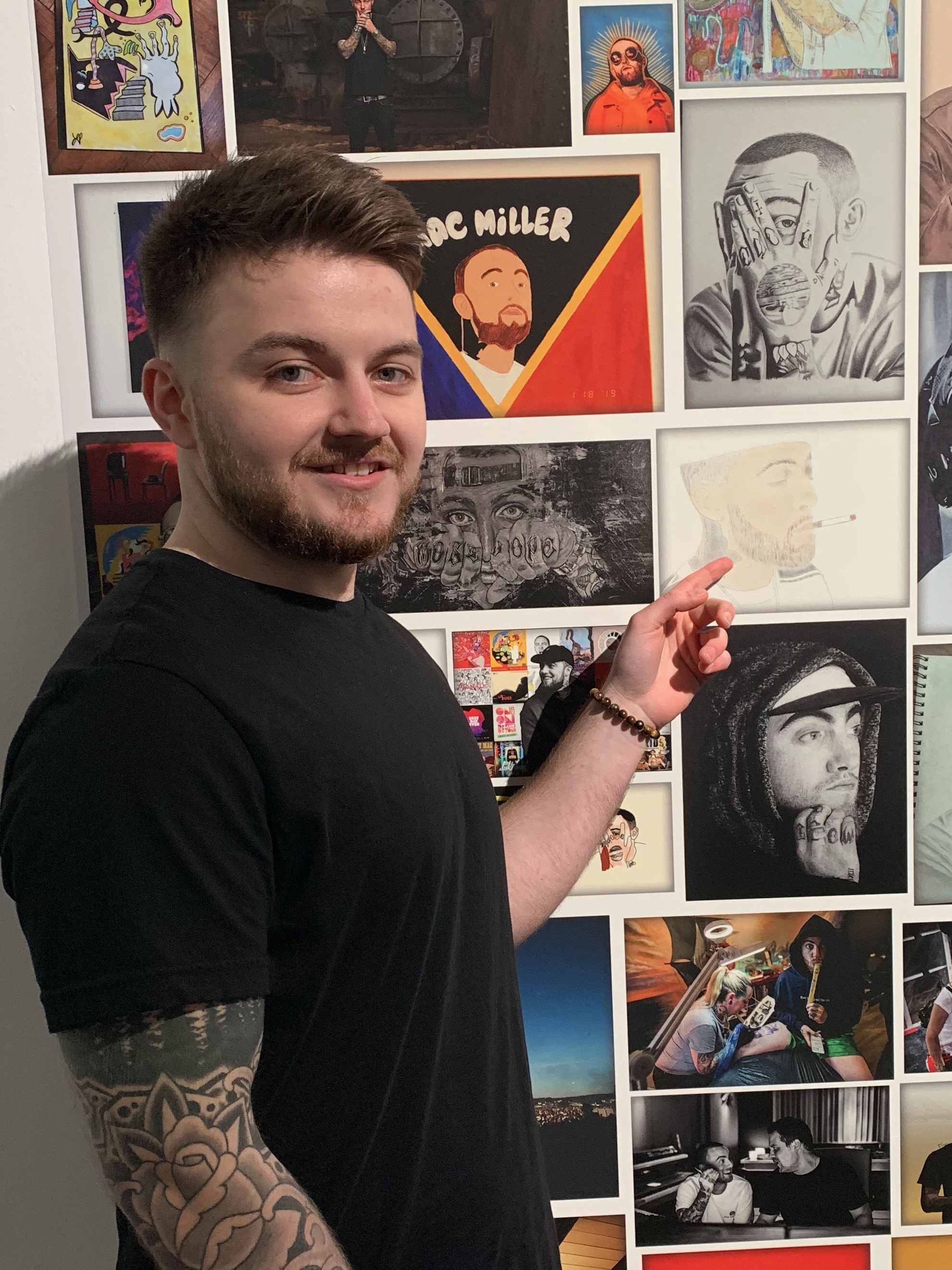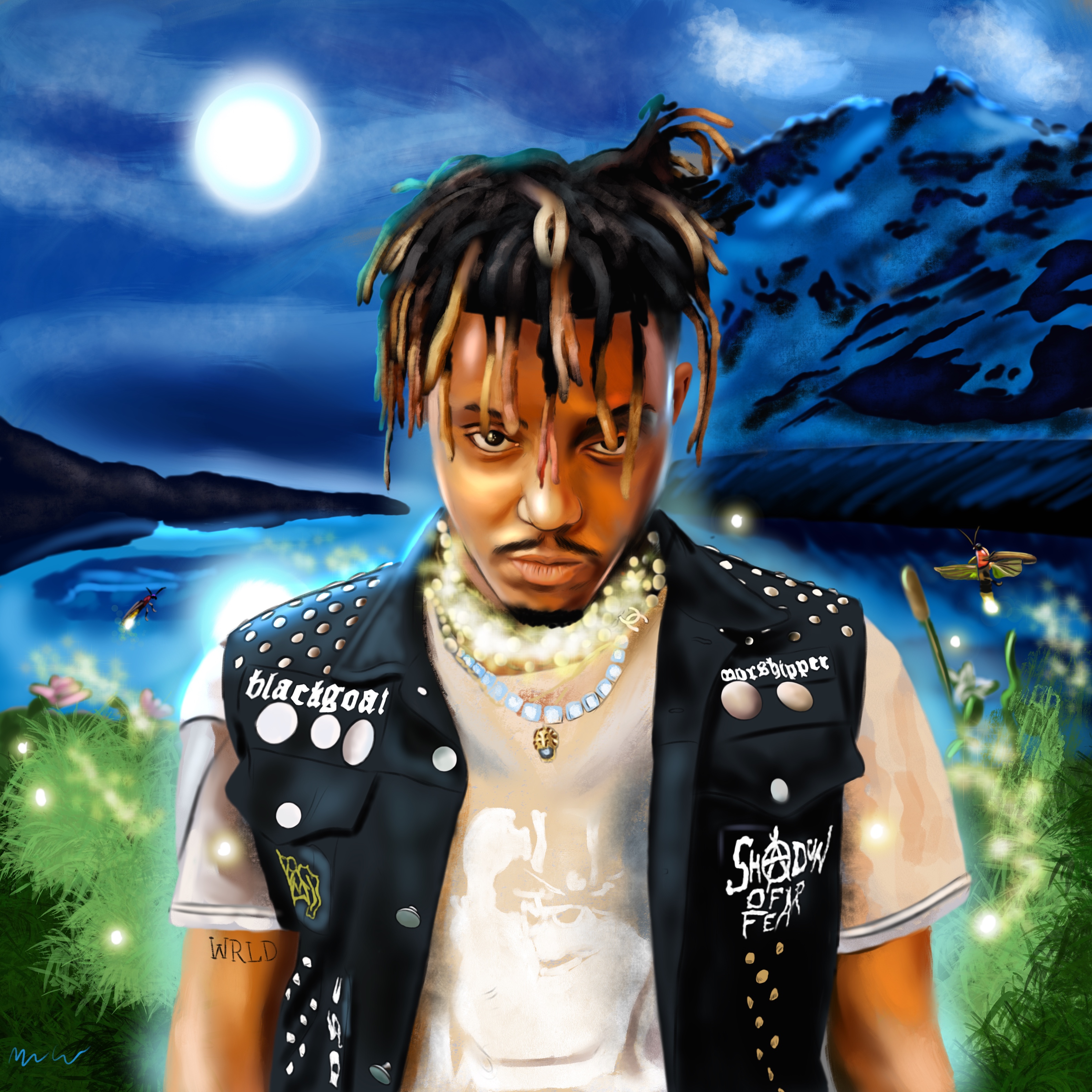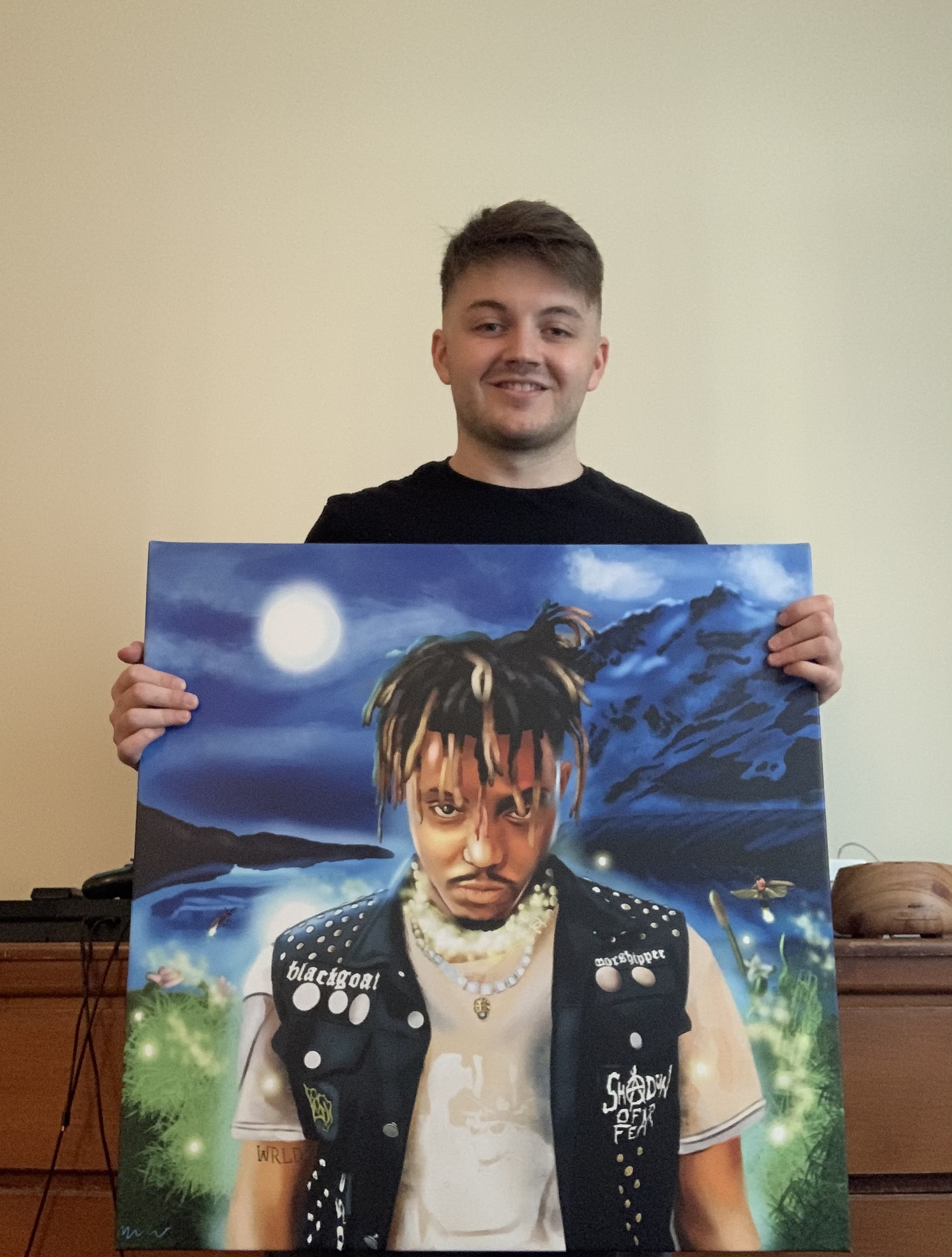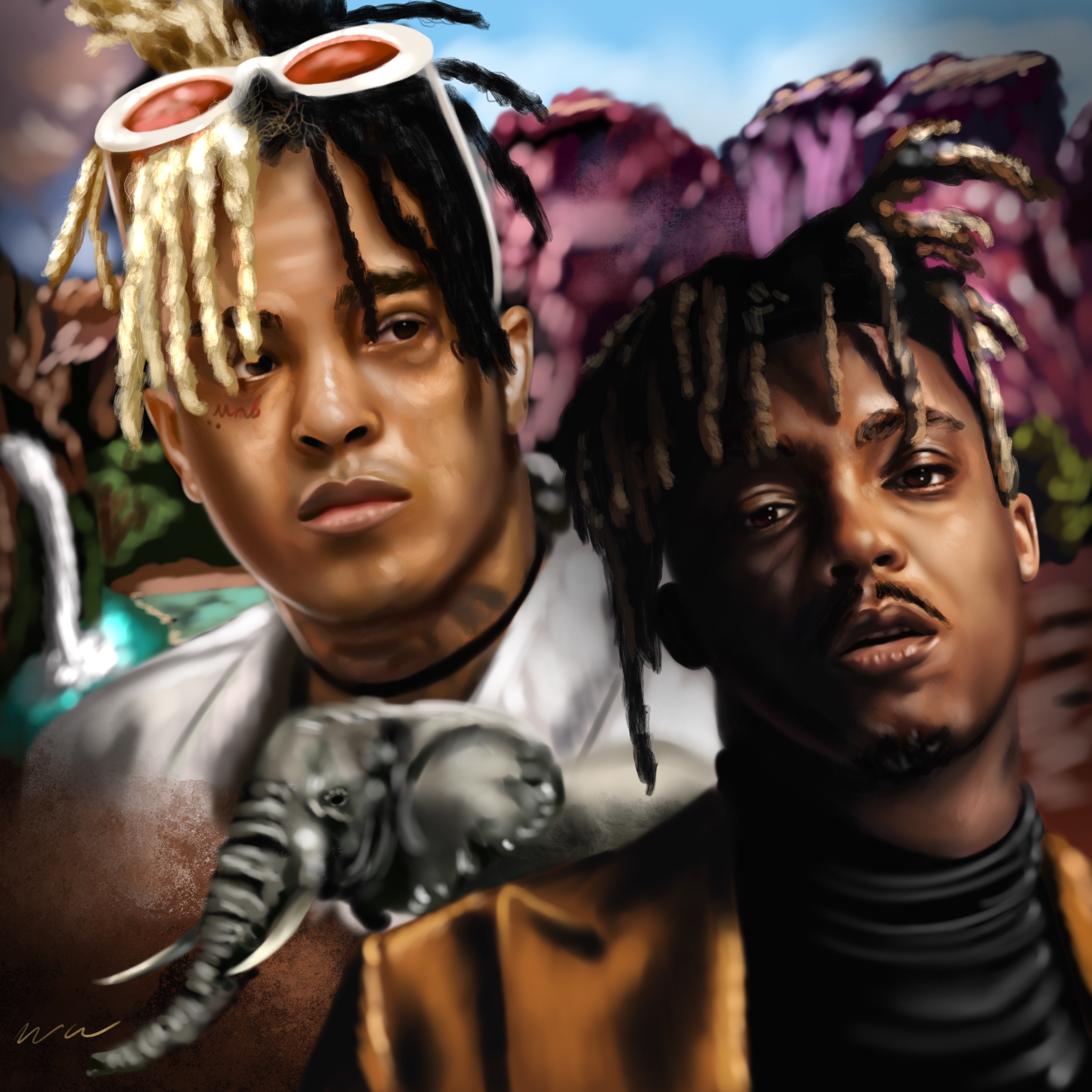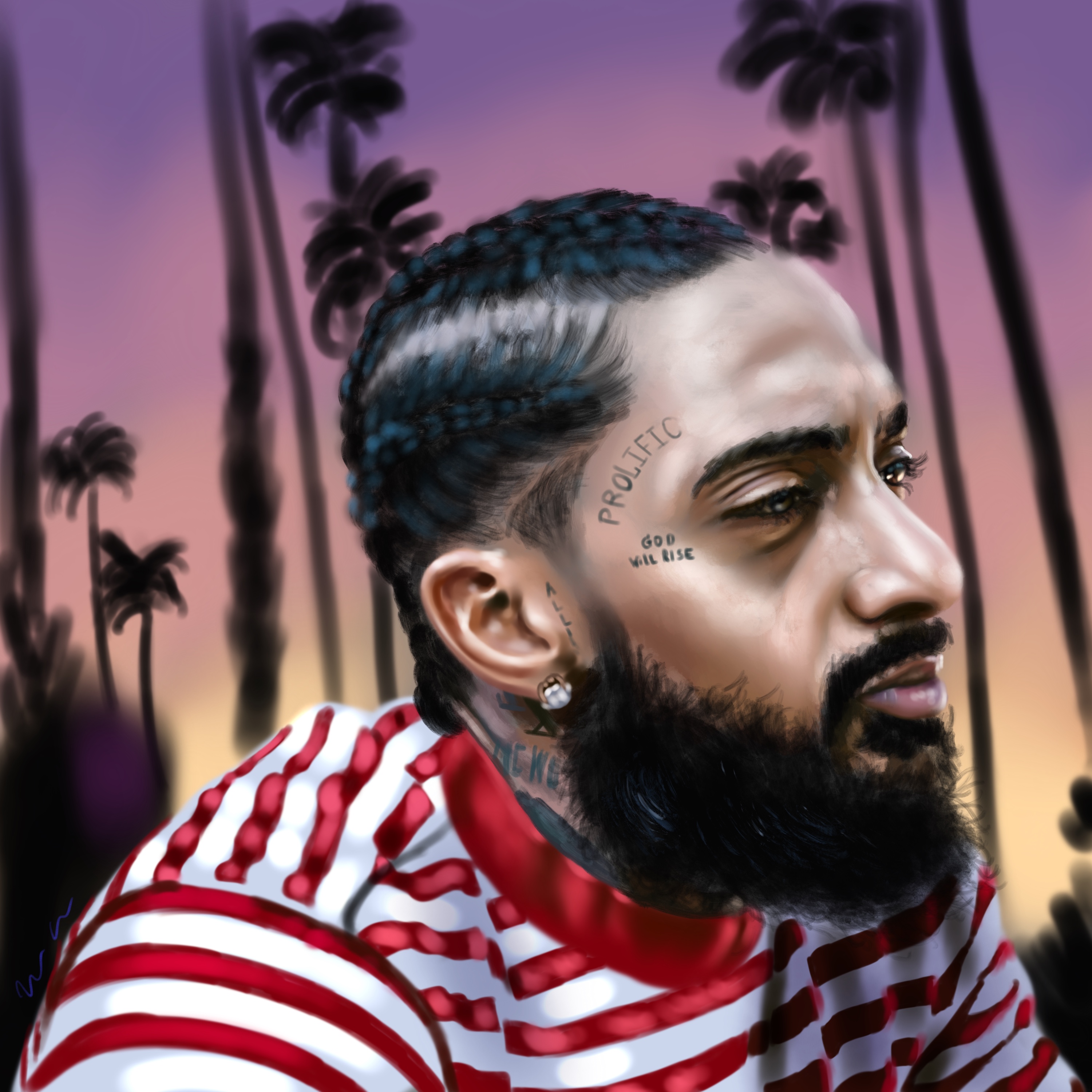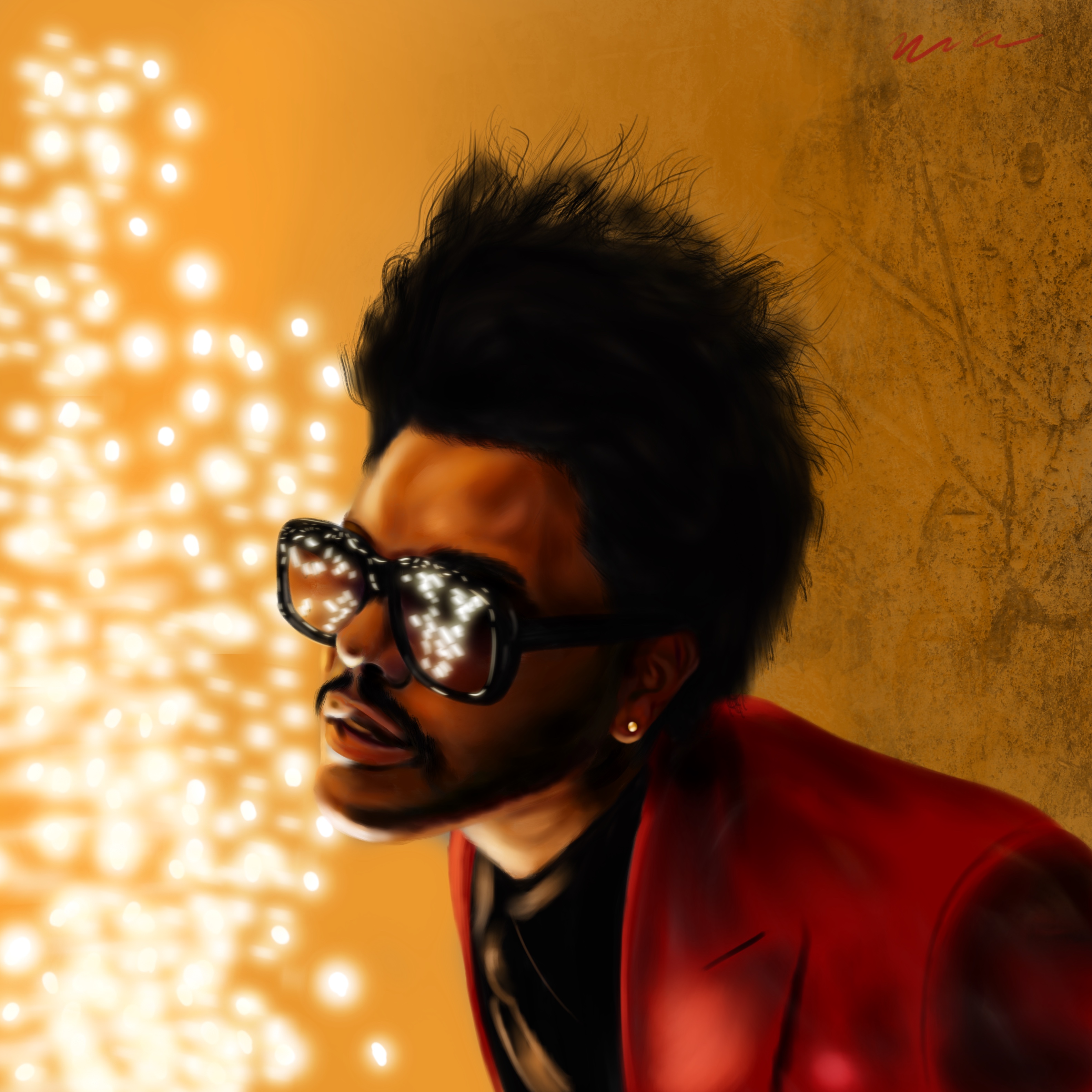For most hip-hop heads, we often enjoy seeing our favorite rappers brought to life by artists through paintings. It’s even more special when artists are able to shed light on the inspiring rappers that have passed away. It feels as if we can keep with us a part of them and what they brought to the culture.
For Mikey Camarda, his passion for art and music goes hand to hand, as he incorporates lyrics and tones into his artwork. The 23-year-old focuses on airbrush painting and digital acrylic to shed light on hip-hop artists that have influenced him. Camarada’s Mac Miller art piece was even featured at the Circles pop-up shop and listening party with the help of Warner Music Group and a Mac Miller fan page from Instagram. The art show came as a surprise to many, but especially to Camarda since he submitted his work with no expectations and landed a spot in it.
True Urban Culture was able to speak with Camarda about his passion for art, his experience attending and being featured in the Mac Miller pop-up show, and how he navigates digital art.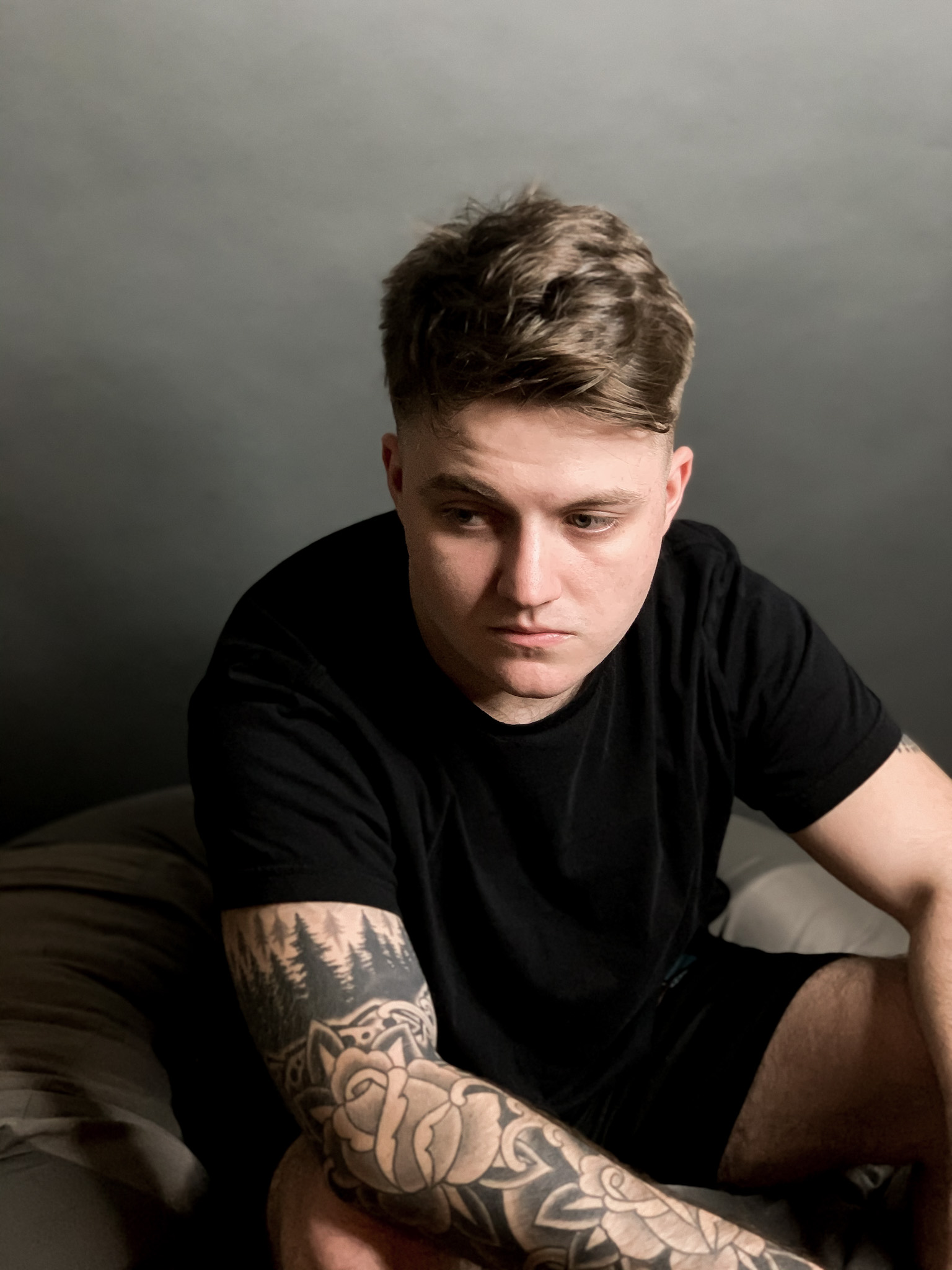
1. How did your passion for art begin?
My passion for art began actually when I was younger. I was really fascinated with a lot of the classic movie posters, album covers, game covers, things like that because usually, I found it like a famine. It’s not just one picture of somebody it’s usually a collection of multiple things going on at once, like a collage of some of those important pieces. And I thought that was really fascinating because if you look at the old movie posters, it’s like Star Wars or Indiana Jones, or somebody famous. You know, films, games, and albums. It’s collecting a very important piece of the story like to make it all in one it’s a very big collage. So it’s really a fascination of just the most important pieces of like a movie, album or game, or whatever it might be.
2. Some of the art featured on your Instagram page showcases airbrush painting and digital acrylic. What guided you towards that medium?
It was basically trial and error that lead me to that. Usually, when I would start out, I would maybe stick to one medium. Let’s say for airbrush, but I didn’t really get the result that I wanted, so I tried to work with a collaboration of both — the acrylic to create more of the texture and the roughness to it. Also bringing in the airbrush to smooth out the shapes, where I needed to do or to provide some of the things from the background, like the geographic features, whether it was mountains, water — things like that. I wanted to make sure it has more features; so that the viewer can be able to have their eyes fixated on multiply things to keep it interesting for them. But, I really enjoy using the acrylic piece because, on the digital side, it really just emulates what a traditional acrylic would look like — the texture would be shown — it’s not just like in an airbrush, where it’s so digital, so common. I really like the texture to it. It gives it more of a personal feel.
3. What would you say is the biggest difference between digital drawing and traditional canvases or sketch pads?
The undo button (Camarda laughed). Definitely, just inventory when I’m doing digital; I don’t have to carry around a bunch of different sketchbooks or canvases. There’s really no mess to it. I could just make the mess on the tablet, itself and since I work with computers and tablets a lot, it’s just much more efficient for me to work with, and I’m able to have everything in front of me at once. I think it’s just mainly efficiency, probably the most important thing for me trying to get as much done as I possibly can, but also doing it right. Sometimes I’ll dab onto sketches on traditional paper, but I don’t know I think just being able to have all the options at once on the tablet just makes it so much more fun. It feels like you have so much more control, which is really cool.
4. I noticed a lot of your work focuses on hip-hop artists. What attracts you to create that type of artwork?
That’s pretty much the basis of all my work, and it’s just really fun to work with. I’m the type that has my headphones in all the time, and I’m able to really kind of enjoy the music as I go and work on the pieces. But essentially, the inspiration from my work pretty much originates from the aggregation of many different influences. And essentially, what I want to do is mix beauty and power, and this can be seen when you look at one of the artists like if it’s a Juice Wrld piece, a Frank Ocean, or whatever the case may be. I want to be able to capture that tone, pose, and everything like that because I enjoy the music so much. I wanted to create the harmony between the most natural environments and pretty much the tones, the frequency, and vibrations that you’re experiencing through the music cause they all tell a different story. You know, there has to be some sort of sense of harmony between the two because there is. Like Rick Rubin once said, one of the most famous producers, ‘the power of nature is such that it’s what all art strives to be.’ Like when you’re listening to music, it’s creating a picture of something in your head, and just trying to materialize that fantasy, or realism to whatever that natural environment is, and just bringing harmony between the two.
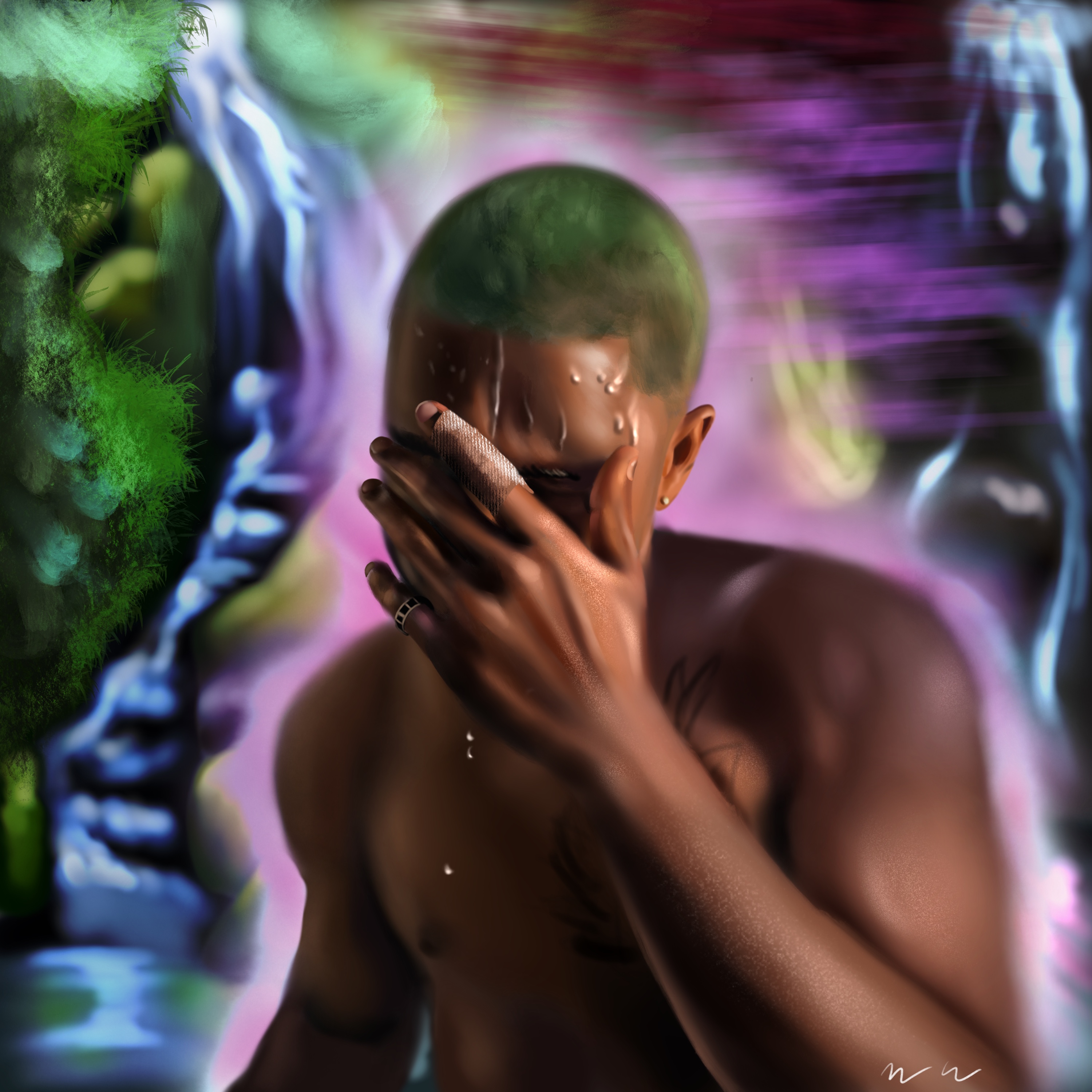 5. Your drawing of Mac Miller was featured at the Mac Miller listening parties in Los Angeles, New York, and Pittsburgh. How did that come about?
5. Your drawing of Mac Miller was featured at the Mac Miller listening parties in Los Angeles, New York, and Pittsburgh. How did that come about?
It was actually really random. I think it was a year ago, last year in November, and one of these [fan] pages I followed on Instagram sent a link — I didn’t know the intentions behind it — it was pretty much a link to this Mac Miller drawing contest thing. And I was like whatever; I had a couple of graphite pieces that I’ll just send over. I didn’t really think much of it. Then, like a week later, I get an email from Warner Music Group, one of the representatives hit me up. And I was like, wait, what? What did I do to get this email? Then they couldn’t tell me at first [what everything was about] because, you know, this is what led up to Circles. At the time, nobody really thought another album was coming out. They pretty much informed me on what it was for — it was for a project, and I was able to work with Mac Miller’s team at Warner Music, and they pretty much let me know that the piece would be in L.A., New York, Pittsburgh and I believe Australia was in one of them, it was like a private show or something like that. But yeah, I was able to go to the BOM gallery — I think it was on Fairfax where it happened — so it was really cool.
6. What were your thoughts when you found out that your work would be part of that?
‘Oh shit, this is crazy.’ Growing up — I’m only 23 right now — and just to be able to live through the genesis of Mac Miller’s career, to be a part of that development, to actually see the maturity and just the changes it seems, like how it evolved. It’s just truly special to see it from the beginning, and hopefully, there’s more to come. It just felt unreal because I was able to be a part of something that I’ve always loved his music and loved everything about what he made. It’s just really cool — one of my idols.
7. Can you describe your experience at the Mac Miller event?
It was really cold outside at the time, and the line was like three blocks long, or so. I was like, ‘Oh man, this is crazy.’ I didn’t think I could even go in to see my own work, but I actually got in. It closed at like 9 or 10 P.M. There were so many people because it was a pop-up for like two days — I want to say it was that weekend. So I was like, I have to find a way to get in there. I hit up my representative from Warner Music, and she did a fantastic job in sending the message out to the people that were there. She was actually in New York, and I didn’t expect a reply. I thought, maybe she’s asleep or something. We just go to walk right in the front and got right in, I brought my brother, and it was an awesome experience. I was able to see, not only my work, but I got to see other people’s work, and eventually, at the end, I talked with some of the artists that were on the West Coast about their work. It was just really cool to share the experiences, their whole process, and all of that. It was just so cool. It was so intimate. It was very small, and there was a ton of people, but it was just cool to see all of those memories coming back like, ‘Aw man, I remember this year when he dropped that album.’ And we were just kind of talking with the other people there. But it was cool to see my work on the wall and see my name up there – I really enjoyed the experience.
8. What inspired that specific piece that you drew for the Mac Miller event?
I made that piece in 2019 in the summer. I can’t remember which month, but I got the tablet in May, so I pretty much moved from traditional to digital right there on the spot. I felt like I wanted to give back to what he did for the community — all the music and the art that he shared with everybody. It was a personal tribute to what he’s given us throughout all those years. I actually didn’t post or anything like that until at least the event came about. I just wanted to keep that in my iPad and the only time I shared was when I had that link, and I shared it for the contest. I wanted to express how I felt cause he gave so much for us, and it was unfortunate that he passed away that previous year in 2018, and it was just a good way to express how I felt.
9. If you could give one of your artworks to one of your favorite rappers, who would it be? And why?
That’s such a tough question (Camarda laughed). I really do love the Mac Miller piece, and I love all of my work that I make, and I have nothing against anybody. I think the one I would give to one of the rappers — if they were still here — it would be the Juice Wrld piece, where it was like, The Legends Never Die same pose and cover, but I changed the background up to where it was like the icy blue, like mountain scene and it just seemed cold with the moonlighting in the background. And the front is where I have like the plants, the lightning bugs, [and] the fireflies. Just like that beauty between how cold and freezing it could be in the back, but once Juice is standing around this area, it’s just all this biological life everywhere — these organisms. It’s just life, and it’s great. I would love to share that with him.
10. I read that you work as a digital artist in the performance marketing industry. Can you tell me a little bit about that?
Basically, when I’m not creating art, I’m heavily involved in the performance marketing world as well. I actually studied in Hawaii. I grew up in San Jose, CA — up in the Bay Area. I moved out to Hawaii to study and try to experience different things there, and it was a fantastic opportunity. It really helped my evolution, you know, just as an overall person, and it was great cause I was able to study and meet a lot of great people there. Essentially, after I graduated from Hawaii, I moved to L.A. shortly after and was able to land a position for a performance marketing agency. From there, I’ve been able to learn a lot just about business and just continuing the strong work ethic and having a lot of cool opportunities to get involved and applying those lessons from the business world to the art world. I think it’s important because you’re really representing yourself as an artist. You have to figure out a way to do it to the best of your abilities and get your name out there as best as you possibly can, and you still have to be a businessman at the same time. I mean, you try to do both.
11. How do you find yourself balancing your career, personal time, and being able to design a piece?
Especially with the way this year’s going, all-time feels the same, and nothing has really changed. Every day feels the same. I mainly have just been allocating my time. Which has been great to focus on my work — for business — and also for artwork. I’m mainly focusing on that, and I dedicate essentially all my time to it this year, which is fantastic cause it’s really helped me in my evolution. But as soon as I’m done working for the day — for the company — I’ll come back and exactly I’m starting my artwork. I love it. It doesn’t feel like a job. It’s just something to help kind of cope or dissociate from that analytical side that really left-brain thinking with all the numbers and everything like that. It’s just a great mechanism after working a lot with numbers and all that.
When I’m making a piece, you have to tap into these concepts, trying to bring the harmony together, like I mentioned earlier. Essentially what I could do to dissociate from that left brain activity and focus on the right brain, so to get away from that, I’ll go outside, spend time walking. Really spend as much time in nature or things like that and just do things that are fun — working out — so I’m not thinking all the time. That’s really when you’re downloading all those really cool concepts, and I try to write it down as quickly as I can, so I can get ready to focus on the next piece. It’s really just separating out the two brain activities.
13. Has the pandemic affected your creativity in any way? If so, how have you found inspiration to continue?
It certainly has affected creativity, not only for me, but I’m sure everyone else as well. It’s definitely been a tough year for everybody, but I would say it has forced a lot of artists to kind of just hunker down, and it feels like, you have more time to work on what you need to do. So I felt like it sparked up a lot of creativity because I was able to have more access, and I was looking at more things on Instagram just concepts from other artists. I would talk to them [artists] a lot, just kind of see what their process is and kind of learning from them. Then also, just spending time outside into parks and things like that and whatever evoking creativity. It definitely helped in a way, where it forces you to really just sit down and focus on what you need to do and how you want to articulate your next piece.
14. What are some challenges in general that you have faced as an artist thus far?
I would say some of the challenges would be when you’re finishing up a piece, and you don’t know what to do next. I don’t know if I would call it an artist’s block or something like that. But it seems like with every new piece, going into it – I learned this from somewhere, I just can’t remember off the top of my head where – but essentially, when I’m coming up with a new piece, I’m starting from nothing. I don’t know anything about it and nothing at all, and like in life, as you grow older you start to figure things out, and it kind of feels like that way. You’re just really starting from nothing. You start from being an amateur at what you know, and then as time goes on, now you understand how you really want to formulate this piece. How you want to make it look the way you’re envisioning it. It’s just not trying to force it, but just try to understand it I think. Especially if I’m listening to music and I just want to understand the tone to it – not only the lyrics too – but just how they’re saying it, rapping it, or singing it. It’s like you’re a baby to start out, and you’ll keep growing.
 15. What advice would you give to a young artist on the rise?
15. What advice would you give to a young artist on the rise?
I feel like it’s really easy to get fixated, especially if someone is out there sharing their work to social media, and you open yourselves up to a lot of things — criticism, achievements, things like that. I would say, don’t focus on trying to get as many likes as you can, or trying to get as many people to say how good your work is, or things like that. At the end of the day, you just want to really just share your vision and what you created. And don’t rush it too. I probably would tell them to take as much time as you need for it. I’d rather have the highest quality of work than just you’re pumping out five pieces in five days, like all right, you need to slow down here for a second. And it’s something that I had to learn too. When you open yourself up to these things, it is risky, and people are going to say things that you won’t like, but at the end of the day, you’re just going to have to keep learning. Like all I care about when I make my work is just: can I share my vision with others, and can I learn from it? That’s essentially all I’m looking for. So, try not to get fixated on the statistics and too much of what people are saying because that’s not why you do it.
16. What are some future goals that you have for yourself as an artist?
Some of my future goals are to definitely to continue to keep learning about myself in the way I take my artwork and what else I can possibly do to improve upon that and also share the vision that I imagine. But hopefully, in the future, when things start opening up or — I’m not too sure what it will be like — but I just want to make a large impact on the world of arts and also an impact on the business world as well. I don’t want to limit myself to just one thing because I think, once we start focusing on, oh, I’m only working to get this achievement or this position, or whatever it might be, what happens when we get to that position or achievement? Are you still happy? Are you still motivated? What happens after that? I mean, usually, in the end, people aren’t happy, or they aren’t motivated. I think the most important thing is, I just want to keep focusing on the journey, which is really like the true destination to continue to move forward.
17. If you had to choose, which piece out of your collections would you say is your favorite?
My favorite would definitely be that Juice Wrld one that I mentioned earlier, but also one of the recent ones I made was the Nipsey Hussle one, where it was him with the red striped shirt that he wore, and I really like the roughness and texture of the beard, with the skin and closer to the eyes. I really enjoyed the texture of that. But also, in the background, I wanted to give it more of a soft airbrush feel because I put palm trees in the back, and it’s like the sun setting, which makes the sky colors look more like it’s at dusk. The colors kind of look like Laker colors, so it reminds me of just like Nipsey being the heart of the city and just that cool association with L.A. It just looks good with the Palm trees, the silhouette in the back, and it’s just really enjoyable, and I love that texture to it.
18. In three words, how would you describe your art?
I would like to describe it as genuine because it’s something that’s coming from my vision. Unique because it’s got so many elements at once. And harmonious just how the scenes are all tied together. That’s how I would describe it really. Genuine, unique, and harmonious because they’re all connected in some way
19. Do you have something you’re currently working on that we should be on the lookout for?
I actually just finished up a Juice Wrld and XXXTentacion piece that I just finished up recently. That one was just shared today on Instagram, but I’m considering multiply things at once. I have started work on another Mac Miller piece, but I don’t know the direction in which I want to go on it with it. I’m going to keep working on it until I think I find something interesting. And I also want to do another Weeknd piece because I really enjoyed an After Hours piece that I made, and I thought that was really cool. I think I want to try to make another one of those from After Hours since he got snubbed at the Grammys. I did not expect that one. On that Weeknd piece, there are two versions of it that one was just the regular one, but I made another one with an animation to it and behind the Weeknd is this twilight zone almost swirl. And through animation, I was able to make it swirl almost like it was a hypnotic feeling. Like his hair kind of flowing and some of the lights are moving and things like that. I also put that one on my Instagram too. Just kind of creating that feeling as to like that trippiness of some of the Blinding Lights theme.
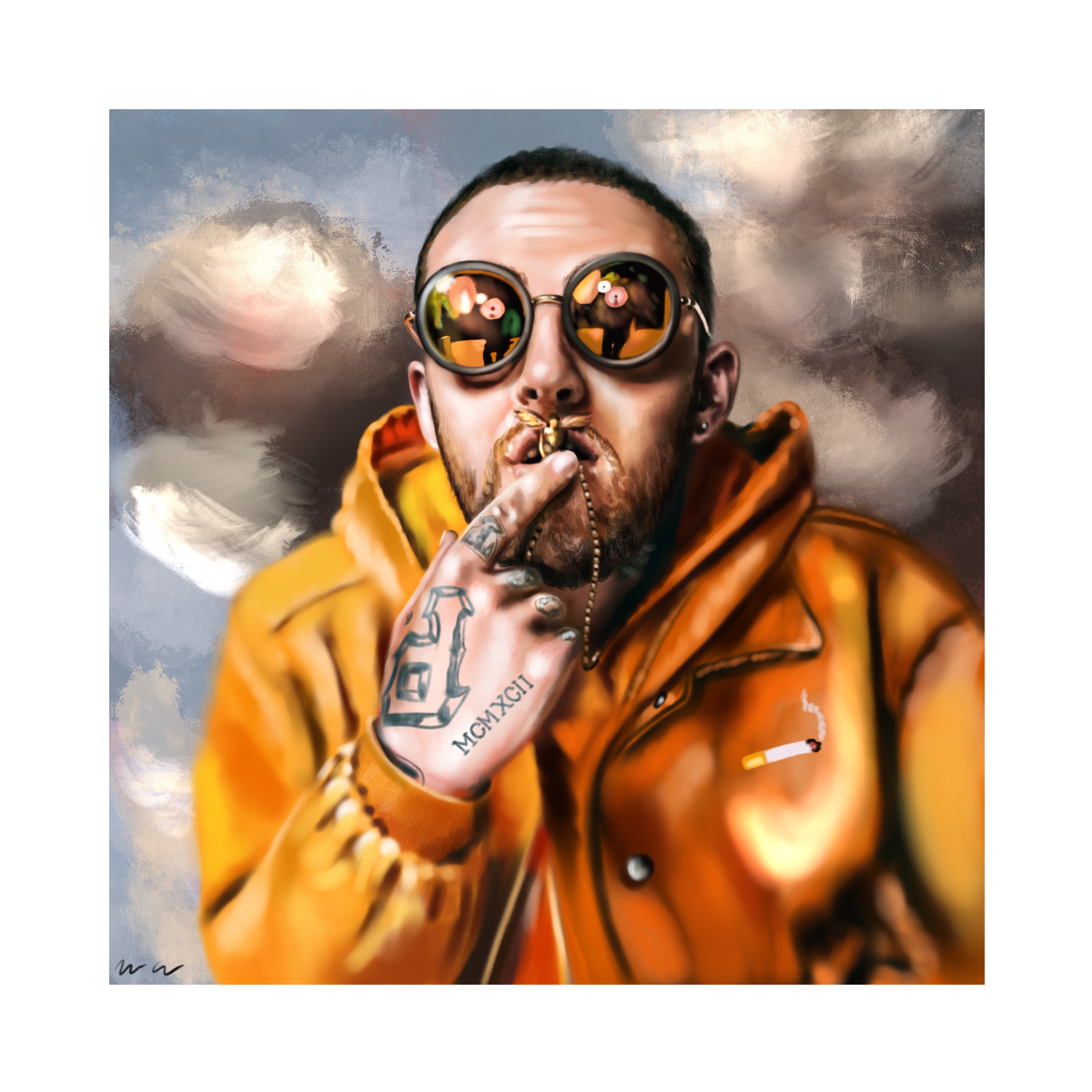 20. What does True Urban Culture mean to you?
20. What does True Urban Culture mean to you?
What it means to me is just expression, being able to provide a voice for everyone to express their creativity and to inspire others, pretty much. I was able to check out some of the artists that you mentioned earlier, and I was looking at their work like, ‘Damn, these guys are really good.’ Essentially just being able to share where they come from and how honest they are, and it’s just really important because people don’t want to forget about that, and it’ll just continue to inspire others.
You can follow Camarda on Instagram for his latest artwork.


